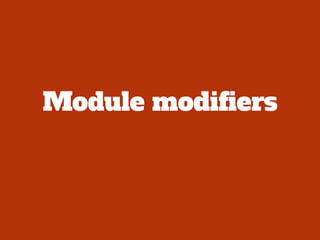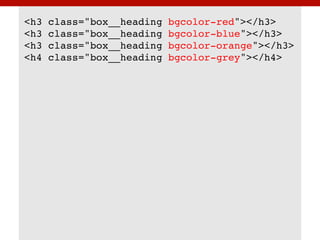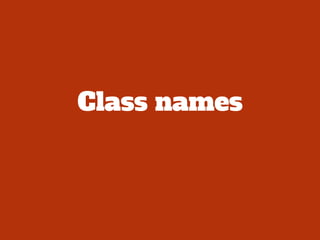CSS pattern libraries
- 3. Began in the web in 1995 Full CSS sites in 2002 Skills: UX, front-end dev, training Recently: CSS pattern libraries
- 4. I have helped develop HTML/ CSS pattern libraries for very large sites (media and university sites) and complex applications (banking applications).
- 5. In some cases, there are literally hundreds of CSS, SCSS or LESS files to review and optimise as part of the process.
- 7. A few years ago, many front end developers approached websites and web applications as a series of “pages”.
- 8. Pages were often designed and built as complete entities. This meant that page components were often closely tied to their relevant pages.
- 9. More recently, the focus has shifted from full page layouts to re-usable components.
- 10. A re-usable component could be a layout grid structure, a button, an input, a drop-down, a menu, a heading, a table, or even a pullquote.
- 12. HTML/CSS pattern libraries are used to resolve commonly used interface components. These components are created as HTML and CSS code and documented, so that they can be easily re-used as needed.
- 13. The terms “style guide” and “pattern library” are often used interchangeably.
- 14. A style guide is a set of standards for implementing the overall design, and can include corporate branding, color schemes, layout and more.
- 15. Style guides are used to ensure uniformity of the design or “brand” across all aspects of the website or application.
- 16. On the other hand, HTML/CSS pattern libraries generally document code components for all aspects of the website or application.
- 17. On larger web projects, style guides and HTML/CSS pattern libraries are generally separate entities.
- 18. For smaller web projects, style guides and pattern libraries are often combined into one overall entity.
- 19. cons? Pros and
- 20. Why use a pattern library at all? ! Easier to build sites Easier to maintain sites Easier to hand over Better workflow Shared vocabulary Promotes consistency
- 21. What are the downsides? ! Time-consuming to write Often done post-project Serve current need only
- 23. There are a wide range of pre-existing pattern libraries available today.
- 24. Some of these pattern libraries have a simple purpose - such as responsive grid systems.
- 25. Grid-based CSS libraries 1140 CSS Grid Mueller Grid System Responsive Grid System Responsive Grid System Less Framework 960 Grid System Susy 320 and up http://cssgrid.net/ http://www.muellergridsystem.com/ http://www.responsivegridsystem.com/ http://responsive.gs/ http://lessframework.com/ http://960.gs/ http://susy.oddbird.net/ https://github.com/malarkey/320andup
- 26. Others are considered full “frameworks” that offer a wide range of components.
- 27. These can include: ! Reset styles Grid systems Typography styles Browser fixes Common user-interface component styles
- 29. There are some great benefits to using an existing framework: ! ready-to-use solution can pick & choose components easy implementation quick prototyping great for teams
- 30. There may also be some downsides: ! may not suit your project no need for a complex library someone else’s conventions generic look
- 31. Bootstrap
- 32. Bootstrap vs. mid-range website
- 33. Bootstrap vs. University data site
- 34. Bootstrap vs. Banking application
- 35. Should you use a pre-existing framework? It depends on the needs of the site and your team. There is no one answer.
- 36. Assuming you want to create your own CSS pattern library, how do you go about it?
- 38. Abstraction is essential to any CSS pattern library.
- 39. The process involves: ! looking for components that may be repeated within the layout defining their characteristics creating HTML/CSS patterns for them 1. ! 2. 3.
- 43. These boxes look like they have similar characteristics. If they were resolved into a pattern, this would make our HTML and CSS more efficient.
- 44. What are the key things to keep in mind when creating any pattern?
- 45. Avoid using IDs
- 46. All patterns needs to be class- based so they can appear as many times as needed within an HTML document.
- 47. /* avoid */! #signup-box { }!
- 48. Avoid naming based on content
- 49. We should avoid naming patterns based on the content, as we want to reuse these patterns often within the layout.
- 50. /* avoid */! .signup { }! .member { }! .member-news { }! .wiki { }! .support { }! .database { }! ! /* preferred */! .box { }
- 52. All patterns should work regardless of where they’re placed within the layout.
- 53. /* avoid */! .sidebar .box { }! .main .box { }! ! /* preferred */! .box { }
- 54. Avoid widths
- 55. Ideally, patterns should avoid defining widths. Patterns should be allowed to spread to the width of any parent container.
- 56. /* avoid */! .box-wide { width: 500px; }! .box-medium { width: 240px; }! .box-small { width: 120px; }! ! /* preferred */! .box { /* no width defined */ }
- 57. Keep patterns as simple as possible
- 58. Patterns should be defined as simply as possible. Otherwise they can become restrictive.
- 59. .box! {! ! border-bottom: 5px solid #C8C8C8;! ! background-color: #e6e6e6;! ! /* may not be suitable */! ! margin-bottom: 1em;! }
- 60. Don’t undo
- 61. Patterns should not be written to undo other rules. For example, the <h3> element:
- 63. We could be tempted to style the <h3> element with a coloured background - as it looks like this is the “default” appearance for all <h3> elements.
- 64. /* default style */! h3! {! ! padding: 1em;! ! color: white;! ! background-color: red;! }
- 65. But what happens if we needed to use an <h3> element later, and it doesn’t have a background-color? We might have to write a rule to undo our previous one.
- 66. /* default style */! h3! {! ! padding: 1em;! ! color: white;! ! background-color: red;! }! ! /* undoing default style */! .no-background ! {! ! padding: 0;! ! color: #000;! ! background-color: none;! }!
- 67. It is best to avoid over-styling elements or patterns so that they do not have to be undone later.
- 68. /* default style */! h3! {! }! ! /* only when background needed */! .class-name! {! ! padding: 1em;! ! color: white;! ! background-color: red;! }!
- 69. Avoid dependency on HTML structure
- 70. Patterns should not rely on the HTML structure. What happens if the structure changes in some instances - like a different heading level being used?
- 71. <div class="box">! ! <h3></h3>! <div>! ! <div class="box">! ! <h4></h4>! <div>! ! ! /* avoid if possible */! .box h3, .box h4! {! ! padding: 10px; ! ! background-color: orange; ! }! !
- 72. It is always better to create a class-based pattern for any specific styling needs.
- 73. <div class="box">! ! <h3 class="box-heading"></h3>! <div>! ! <div class="box">! ! <h4 class="box-heading"></h4>! <div>! ! ! /* preferred */! .box-heading! {! ! padding: 10px; ! ! background-color: orange; ! }!
- 75. How can we let developers know that our new class called “box-heading” relates to the “box” class?
- 76. <div class="box">! ! <h3 class="box-heading"></h3>! <div>!
- 77. We could use a naming convention that was originally defined as part of BEM: ! http://bem.info/
- 78. And then extended by Nicolas Gallagher: ! http://nicolasgallagher.com/about-html-semantics- front-end-architecture/
- 79. And then modified slightly again by Harry Roberts: ! http://csswizardry.com/2013/01/mindbemding- getting-your-head-round-bem-syntax/
- 80. This naming convention is based on the idea that page layouts can be broken down into a series of re-usable “modules”.
- 81. If a module needs to be modified or extended, a “module modifier” would be used.
- 82. If a module has child elements that need to be styled, a “module descendant” could be used.
- 83. These different types of class names need to be relatable and recognisable.
- 84. /* Module */! .module-name {}! ! /* Module modifier*/! .module-name--modifier-name {}! ! /* Module descendant*/! .module-name__descendant-name {}! ! /* Module descendant modifier*/! .module-name__descendant--modifier {}!
- 85. <!-- Module -->! <div class="box"></div>! ! <!-- Module modifier -->! <div class="box box--alt"></div>! ! <!-- Module descendant -->! <div class="box">! ! <h3 class="box__heading"></h3>! </div>! ! <!-- Module descendant modifier -->! <div class="box">! ! <h3 class="box__content box__content--alt"></h3>! </div>!
- 87. With this naming convention, we can now add two “module descendants” to our HTML markup:
- 88. <!-- Module -->! <div class="box">! ! ! <!-- Module descendant -->! ! <h3 class="box__heading"></h3>! ! ! <!-- Module descendant -->! ! <div class="box__content"></div>! </div>!
- 89. .box! {! ! margin-bottom: 1em;! ! border-bottom: 5px solid #C8C8C8;! ! background-color: #e6e6e6;! }! ! .box__heading! {! ! margin: 0;! ! padding: 10px 15px;! ! text-transform: uppercase;! }! ! .box__content { margin: 15px; }!
- 90. Module modifiers
- 91. But what about the boxes that are very similar, but have some unique characteristics - like the decorative cog image?
- 93. If we needed to modify or extend the original module, we would create a modifier class name.
- 94. <!-- Module modifier -->! <div class="box box--alt">! ! <h3 class="box__heading"></h3>! ! <div class="box__content"></div>! </div>!
- 95. However, in this case, we need to modify the “box__content” class. We need to create a “module descendant modifier”.
- 96. <!-- Module modifier -->! <div class="box">! ! <h3 class="box__heading"></h3>! ! <div class="box__content box__content —cog"></div>! </div>!
- 97. .box__content--cog! {! ! padding-right: 100px;! ! background-image: url(cog.png);! ! background-repeat: no-repeat;! ! background-position: 100% 0;! }!
- 98. Helper classes
- 99. In one of the boxes, there is a piece of text that is aligned to the right. How do we solve this?
- 101. We could make it another module descendant - and apply this to the link.
- 102. .box__link {}! ! ! ! <div class="box">! ! <h3 class="box__heading"></h3>! ! <div class="box__content">! ! ! <p class="box__link"></p>! ! </div>! </div>! !
- 103. Or we could use a different type of class, called a “helper” or “utility” class.
- 104. Nicolas Gallagher’s SUIT CSS includes a set of classes called “utilities”. ! https://github.com/suitcss/suit
- 105. /* Utility classes */! .u-utilityName {}! ! ! <!-- example markup --> ! <article class="Tweet">! ! <a class="u-floatRight"></a>! ! <div class="u-sizeFill">! ! ! <a class="u-linkComplex"></a>! ! </div>! </article>!
- 106. Bootstrap also uses these types of classes, but calls them “helper” classes. ! http://getbootstrap.com/css/#helper-classes
- 107. /* Utility classes */! .text-muted { color: #777; } ! .text-primary { color: #428bca; }! .text-success { color: #3c763d; }! ! ! <!-- example markup --> ! <p class="text-muted">...</p>! <p class="text-primary">...</p>! <p class="text-success">...</p>
- 108. These types of classes are designed to be added to elements where needed, without having to resort to styling elements individually.
- 109. /* Helper classes */! .h-text-right { text-align: right; }! ! ! ! ! <!-- example markup --> ! <p class="h-text-right">! ! <a href="#">More</a>! </p>!
- 110. For front-end developers who grew up in the “keep your markup clean” era, these classes could be considered the work of Satan.
- 111. I’ve found them to be invaluable - when you need to add a single function to an element without having to create a specific class.
- 112. Theme classes
- 113. In 2011, Jonathan Snook introduced SMACSS. One of the key principles is to categorise CSS rules into five different categories. ! https://smacss.com/
- 114. Base - HTML elements Layout - grids Module - reusable components State - states of modules etc Theme - theming modules etc
- 115. These categories are a great way to break up huge chunks of CSS rules into manageable sections.
- 116. We could use one of these categories - theme styles - to define the background-colors on our headings.
- 118. <h3 class="box__heading bgcolor-red"></h3>! <h3 class="box__heading bgcolor-blue"></h3>! <h3 class="box__heading bgcolor-orange"></h3>! <h4 class="box__heading bgcolor-grey"></h4>!
- 119. .bgcolor-red, .bgcolor-blue, .bgcolor- orange, .bgcolor-grey { color: #fff; }! ! .bgcolor-red ! { background-color: #B21F24; }! ! .bgcolor-blue ! { background-color: #1D5980; }! ! .bgcolor-orange ! { background-color: #C56F00; }! ! .bgcolor-grey ! { background-color: #444445; }
- 120. Tips Pattern library
- 121. Here are some tips on the overall approach to CSS pattern libraries.
- 122. Smallest to largest
- 123. In mid 2013, Brad Frost introduced Atomic Design - a methodology for creating design systems with five distinct levels in atomic design. ! http://bradfrostweb.com/blog/post/atomic-web- design/
- 124. Atoms - HTML elements Molecules - groups of atoms Organisms - groups of molecules Templates - groups of organisms Pages - instances of templates
- 125. Atomic design defines the process as starting from smallest components and building to largest.
- 126. Ideally, large components should not need to be defined in a pattern library as they should be build up, like lego, from smaller components.
- 127. Class names
- 128. Establish a class naming convention as early as possible in the process. Then document this convention and enforce it!
- 130. Make sure any class naming convention is easy for others to follow. I have worked on projects where teams are constantly changing, so quick take-up is critical.
- 131. Keep it simple
- 132. I’ve worked on projects where the LESS architecture needs to be mapped out in spreadsheets in order for teams to understand. In almost all cases, this was unnecessary. Keep it as simple as possible.
- 133. Final thoughts?
- 134. Bottom line: HTML/CSS pattern libraries are an important tool for anyone doing CSS today no matter how large or small your website. Get out there and get busy!
- 135. Russ Weakley Max Design ! Site: maxdesign.com.au Twitter: twitter.com/russmaxdesign Slideshare: slideshare.net/maxdesign Linkedin: linkedin.com/in/russweakley







































































































































